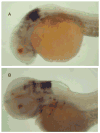The negative side of retinoic acid receptors
- PMID: 21767634
- PMCID: PMC3208776
- DOI: 10.1016/j.ntt.2011.06.006
The negative side of retinoic acid receptors
Abstract
This is a review of research that supports a hypothesis regarding early restriction of gene expression in the vertebrate embryo. We hypothesize that vertebrate retinoic acid receptors (RARs for several vertebrates but rars for zebrafish) are part of an embryonic, epigenetic switch whose default position, at the time of fertilization is "OFF". This is due to the assemblage of a rar-corepressor-histone deacetylase complex on retinoic acid response elements (RAREs) in regulatory regions of a subset of genes. In addition, selective and precise allocation of retinoic acid during early development through the interaction of Phase I enzymes throws the switch "ON" in a predictable, developmental manner. We are proposing that this is a basic, early embryonic switch that can cause the initiation of cascades of gene expression that are responsible for at least some early, diversification of cell phenotypes. Dehydrogenases and a subset of cytochrome p450 genes (cyp26a1, cyp26b1, and cyp26c1) play the major role in providing the retinoic acid and limiting its access. We also suggest that this mechanism may be playing a significant role in the repression of genes in undifferentiated stem cells.
Copyright © 2011 Elsevier Inc. All rights reserved.
Conflict of interest statement
Figures








References
-
- Castillo HA, Cravo RM, Azambuja AP, Simoes-Costa MS, Sura-Trueba S, Gonzalez J, Slonimsky E, Almeida K, Abreu JG, de Almeida MA, et al. Insights into the organization of dorsal spinal cord pathways from an evolutionarily conserved raldh2 intronic enhancer. Development. 2010;137:507–18. - PMC - PubMed
Publication types
MeSH terms
Substances
Grants and funding
LinkOut - more resources
Full Text Sources
Miscellaneous

